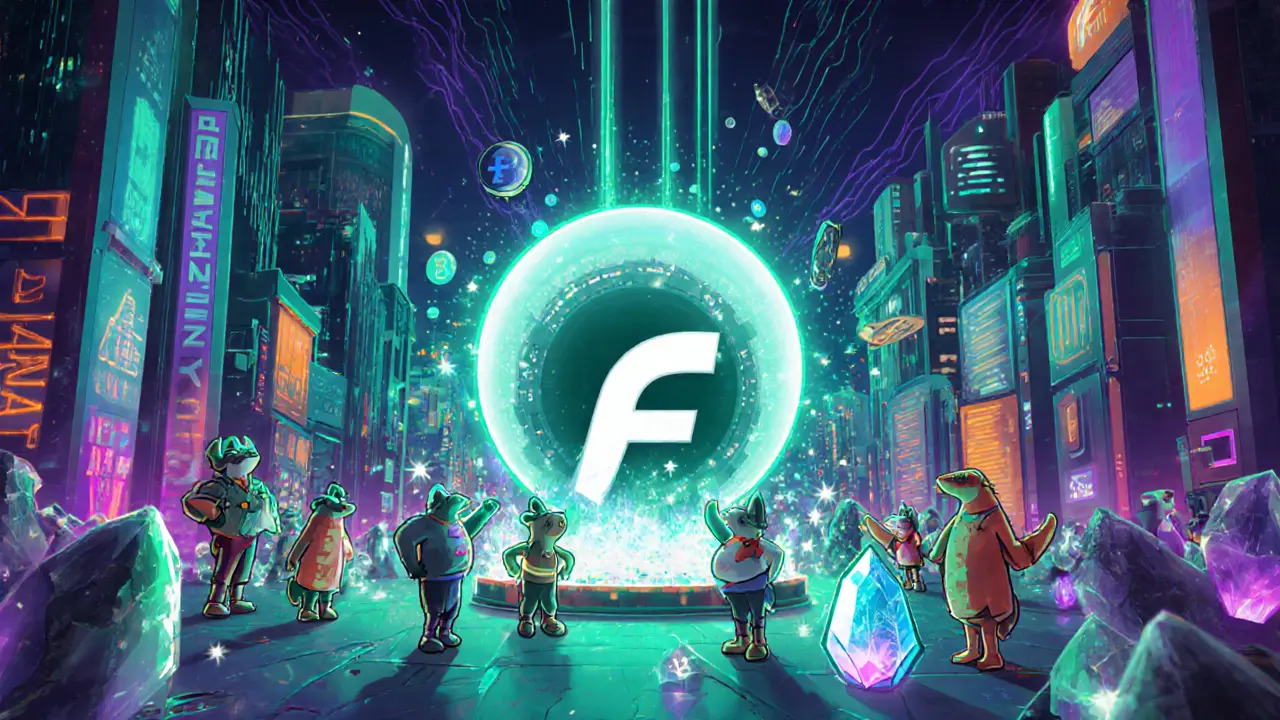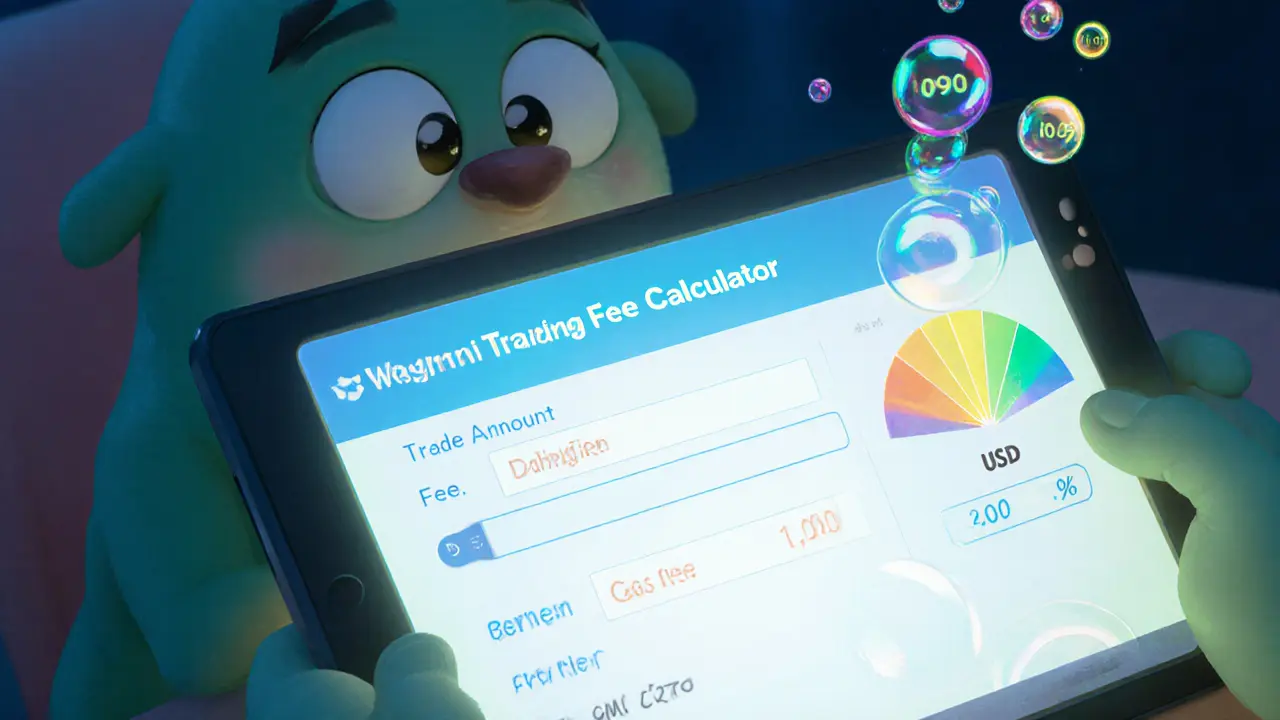Wagmi (Fantom) Trading Fee Calculator
Estimated Trading Costs
Trading Fee
$0.00
Network Gas Fee
$0.01
Total Estimated Cost
$0.01
About Wagmi's Fee Structure
Wagmi offers flexible fee tiers ranging from 0.05% to 0.30%, making it suitable for both small retail trades and larger institutional transactions. With Fantom's low gas fees (typically under $0.01), Wagmi provides cost-effective trading compared to Ethereum-based exchanges.
Quick Take
- Wagmi runs on the high‑speed Fantom blockchain, offering sub‑cent transaction costs.
- Liquidity is decent for popular pairs but thin on niche tokens.
- Audited smart contracts and a built‑in insurance fund boost security.
- Supports Metamask, Trust Wallet, and the native Fantom wallet.
- Best for traders who need fast swaps without worrying about high gas fees.
When you hear the phrase "Wagmi (Fantom) crypto exchange review", you’re probably looking for a clear picture of whether this DEX lives up to the hype. Below we break down the platform’s core pieces - from the underlying tech to real‑world trading experience - so you can decide if Wagmi belongs in your DeFi toolbox.
What is Wagmi?
Wagmi is a decentralized exchange (DEX) built on the Fantom Opera network. Launched in early 2024, Wagmi positions itself as a low‑fee, high‑throughput alternative to Ethereum‑based DEXs. The platform focuses on swap functionality, liquidity pools, and a simple UI that caters to both newcomers and seasoned DeFi traders.
Why Fantom matters for Wagmi
Fantom’s Lachesis consensus (an asynchronous Byzantine Fault Tolerance model) delivers near‑instant finality - roughly one second per block - and can process up to 2,000 transactions per second. Those numbers translate directly into the user experience on Wagmi: trades settle almost instantly and the average gas fee hovers around $0.01, a stark contrast to the $10‑plus fees seen on congested Ethereum days.
Because Fantom is EVM‑compatible, developers can port Solidity contracts without major rewrites. Wagmi leverages this compatibility to import popular liquidity‑pool contracts from the broader DeFi ecosystem, ensuring that token listings and automated market maker (AMM) logic behave as expected.
Key Features and How They Work
- Swap Engine: Uses a standard constant‑product AMM model (x*y=k) with customizable fee tiers (0.05%‑0.30%).
- Liquidity Mining: Offers reward boosts in FTM for early providers.
- Cross‑Chain Bridge: Integrates the Multichain bridge to pull assets from Ethereum, BSC, and Avalanche onto Fantom.
- Governance: Token‑holder proposals are voted on using the native FTM token, allowing the community to tweak fee structures and add new pools.
Fees, Liquidity, and Slippage
On most major pairs (e.g., WETH‑FTM, USDC‑FTM), Wagmi’s average fee sits at 0.10% plus the base network gas of <$0.02. Slippage is generally below 0.5% for trades under $10,000, thanks to the platform’s depth of liquidity. However, smaller or newer tokens can see slippage spikes up to 3% because the pool size is limited.
Liquidity on Fantom surged to over $8billion in early 2022 before a market correction trimmed it to roughly $460million by 2023. While the overall TVL (total value locked) on Fantom has fluctuated, Wagmi consistently holds about 3‑5% of that TVL, putting it in the mid‑range compared to giants like SpookySwap (≈12%) and Curve (≈4%).
Security Measures
Security is a top concern for any DEX. Wagmi’s smart contracts underwent a formal audit by CertiK in March 2024. The audit flagged a few minor gas‑optimization issues, all of which were patched before the mainnet launch.
In addition to audits, Wagmi maintains a treasury‑backed insurance fund that reimburses users up to $250,000 in case of a smart‑contract exploit. The fund is continuously replenished by a 0.02% fee taken from each swap.

Wallet Compatibility and User Flow
Connecting a wallet is straightforward: click “Connect”, pick Metamask, Trust Wallet, or the native Fantom wallet, and you’re in. The UI mirrors familiar patterns from Uniswap, with clear token selectors, price impact warnings, and a one‑click “Add Liquidity” button.
Mobile users benefit from a responsive design and a dedicated iOS/Android app launched in August 2025. The app supports push‑notifications for transaction confirmations and pending swaps, which helps traders keep an eye on market movements without constantly checking a browser.
Pros and Cons Checklist
- Pros
- Ultra‑low fees thanks to Fantom’s sub‑cent gas costs.
- Near‑instant transaction finality.
- Audited contracts and an insurance fund.
- Cross‑chain bridge expands asset variety.
- Simple, mobile‑first UI.
- Cons
- Liquidity can be thin on niche tokens.
- Limited advanced order types (no stop‑loss or limit orders).
- Reliance on a single blockchain (Fantom) may expose users to ecosystem‑wide risks.
How Wagmi Stacks Up Against Other Fantom DEXs
| Feature | Wagmi | SpookySwap | Curve (Fantom) |
|---|---|---|---|
| Average Swap Fee | 0.10%+$0.01 gas | 0.30%+$0.02 gas | 0.04%+$0.01 gas |
| Liquidity (TVL) | $13M | $45M | $20M |
| Audit Provider | CertiK (2024) | PeckShield (2023) | Quantstamp (2022) |
| Insurance Fund | Yes, $2M | No | Partial (via protocol) |
| Mobile App | iOS/Android (2025) | No | No |
Who Should Use Wagmi?
If you value cheap, fast swaps and are comfortable staying within the Fantom ecosystem, Wagmi is a solid pick. It’s especially attractive for traders who move small‑to‑medium sized orders (up to $50,000) and want to avoid Ethereum’s volatile gas fees. For large‑scale liquidity providers looking for deep pools, SpookySwap may still hold the edge, while Curve remains the best‑bet for stable‑coin trading.
Potential Risks and How to Mitigate Them
- Network‑wide attacks: While Fantom’s aBFT consensus is resilient, a coordinated validator attack could jeopardize finality. Mitigation: keep funds in hardware wallets and avoid keeping large balances on the exchange.
- Smart‑contract bugs: No audit can guarantee 100% safety. Mitigation: only allocate a portion of your capital to any single pool and leverage the insurance fund.
- Liquidity crunch: Thin pools can cause high slippage. Mitigation: check the pool’s depth before trading and consider splitting orders across multiple pools.
Getting Started in 5 Simple Steps
- Install a Fantom‑compatible wallet (Metamask, Trust Wallet, or the official Fantom wallet).
- Acquire FTM tokens to cover gas.
- Visit wagmi.exchange and click “Connect”.
- Select the token pair you want to swap, set the amount, and confirm.
- If you wish to provide liquidity, click “Add Liquidity”, approve the token allowances, and deposit your assets.
Final Verdict
Wagmi delivers on its promise of a fast, cheap DEX built for the Fantom network. While it doesn’t yet match the raw liquidity of SpookySwap, its lower fees, audited code, and insurance fund make it a compelling choice for everyday traders. Keep an eye on the platform’s roadmap - upcoming limit‑order support could push it into the premium tier of Fantom DeFi.

Frequently Asked Questions
Is Wagmi a centralized exchange?
No. Wagmi is a decentralized exchange (DEX) that runs entirely on the Fantom blockchain. Users keep control of their private keys at all times.
What wallet should I use with Wagmi?
Wagmi supports Metamask, Trust Wallet, the native Fantom wallet, and its own mobile app. Any wallet that can connect to the Fantom Opera network will work.
How does Wagmi’s fee structure compare to Ethereum DEXs?
Wagmi typically charges 0.10% per swap plus sub‑cent gas fees, whereas Ethereum DEXs often charge 0.30%‑0.35% and gas can exceed $10 during peak periods.
Is there an insurance fund on Wagmi?
Yes. Wagmi maintains a $2million insurance pool that reimburses users up to $250,000 per incident, funded by a tiny 0.02% fee on every swap.
Can I trade tokens that aren’t native to Fantom?
Through the built‑in cross‑chain bridge, you can bring ERC‑20 tokens from Ethereum, BSC, or Avalanche onto Fantom and trade them on Wagmi.


Chad Fraser
June 21, 2025 AT 23:07Wagmi definitely knows how to keep the fees low on Fantom – that 0.05% tier is practically a giveaway for small traders. Combine that with sub‑cent gas fees and you’ve got a recipe for cheap swaps. The UI looks clean, and the calculator they baked in makes it easy to see exactly what you’ll pay. I’ve already tried a couple of trades and the slippage was minimal, which is a huge plus. If you’re on the fence, give it a spin; the cost savings add up fast.
Jayne McCann
June 22, 2025 AT 21:20The fee structure looks nice, but cheap isn’t always safe.
Richard Herman
June 23, 2025 AT 19:33Wagmi’s tiered fees give you flexibility, though the jump from 0.10% to 0.15% can bite larger orders. On Fantom the gas is negligible, so the main cost is the exchange fee itself. It’s good that they’re transparent about the tiers, but users should still watch the order book depth. Security-wise, they claim standard audits, but I haven’t seen any third‑party reports yet. Overall, it’s a decent option if you prioritize low fees over absolute liquidity.
Parker Dixon
June 24, 2025 AT 17:47Great points! 🤓 I’d add that the “Standard” 0.10% tier is a sweet spot for most mid‑size trades – you avoid the higher tier while still keeping costs low. Also, the platform supports limit orders, which can help you snag better prices without paying extra gas for every tweak. Their mobile app mirrors the web UI, so you can monitor fees on the go. If you enable the “fee‑estimator” widget, you’ll see real‑time gas estimates, which is handy during network spikes. Keep an eye on the “Liquidity” tab; it shows where the depth is strongest, helping you avoid price impact.
Stefano Benny
June 25, 2025 AT 16:00While the nominal fee percentages look flattering, remember that “0.05%” is just a marketing veneer – the real cost is hidden in spread and order book depth. If you’re swapping low‑volume tokens, you might end up paying more via slippage than the stated fee. Plus, their “audit” is probably a one‑page PDF that any dev can crank out. In the DeFi world, “low fee” often correlates with “low liquidity,” so proceed with caution.
Bobby Ferew
June 26, 2025 AT 14:13Honestly, the whole hype around cheap fees feels a bit forced; I can’t shake the feeling that they’re compensating with something else, maybe hidden data collection. The UI is slick, but I find myself constantly wondering what’s really happening behind the scenes.
celester Johnson
June 27, 2025 AT 12:27In the grand tapestry of decentralized finance, a platform’s fee is but a whisper compared to the roar of trust. One must ask: does a lower fee diminish the perceived value of the service, or does it elevate the collective good? If we chase the cheapest avenue without scrutinizing the underlying security, we risk eroding the very foundations of decentralization.
Prince Chaudhary
June 28, 2025 AT 10:40Looks solid.
John Kinh
June 29, 2025 AT 08:53Hah, sure, but I still think it’s just another copy‑cat DEX trying to steal the spotlight. 🙄
Mark Camden
June 30, 2025 AT 07:07It is incumbent upon users to demand rigorous, independently verified security audits before trusting any exchange with capital. The superficial presentation of “low fees” should not distract from the necessity of due diligence.
Evie View
July 1, 2025 AT 05:20Stop sugar‑coating it – Wagmi’s “low fees” are a gimmick, and anyone who buys into that is being naive. The platform’s security track record is barely a footnote, and that should be a red flag for anyone with a brain.
Sidharth Praveen
July 2, 2025 AT 03:33Don’t let the noise discourage you; Wagmi’s fee calculator is a great tool to demystify costs, and with Fantom’s near‑zero gas, you can actually see the savings stack up over time. Keep experimenting, and you’ll find the sweet spot for your trading strategy.
Jan B.
July 3, 2025 AT 01:47Indeed. The calculator gives clear numbers and the tier system is transparent.
MARLIN RIVERA
July 4, 2025 AT 00:00Honestly, this is just another cash‑grab. The “features” are nothing you can’t get on bigger DEXs for free.
Debby Haime
July 4, 2025 AT 22:13Love the vibe! The fee tiers really let you scale as you grow, and the low gas on Fantom means you’re not losing money on hidden costs. Keep the community engaged and share your success stories!
katie littlewood
July 5, 2025 AT 20:27When I first stumbled upon Wagmi’s trading platform, I was instantly drawn in by the rainbow of fee tiers glittering like a carnival of possibilities. The lowest tier of 0.05% feels like a secret handshake reserved for the savvy who know how to squeeze every cent out of a trade. Meanwhile, the progressive steps up to 0.30% are purposefully designed to cater to larger whales who can tolerate a slightly heftier slice of the pie. What truly sets Wagmi apart, beyond the alluring numbers, is its seamless integration with Fantom’s featherlight gas costs, which often dip below a penny. This combination means that the total out‑of‑pocket expense for a modest $500 swap can be as low as a few dollars, a figure that makes my accountant do a little happy dance. The user interface, painted in soft blues and whites, invites both rookies and veterans to navigate without the usual labyrinthine menus that plague many DeFi sites. I particularly appreciate the built‑in fee estimator widget, which updates in real‑time as market conditions shift, giving you a crystal‑clear picture before you click ‘confirm.’ Security-wise, Wagmi touts standard audits, but I recommend digging up the actual audit reports and scanning community forums for any red flags before depositing large sums. Liquidity pools on the platform, while not as massive as Uniswap’s, are growing steadily, and the depth charts show promising stability for most mid‑range assets. If you’re a trader who thrives on low‑fee arbitrage, the tiered structure can be leveraged to optimize profit margins across multiple trades in a single session. For those who are more risk‑averse, the platform’s limit order feature allows you to set price points without constantly monitoring the market, thereby reducing exposure. Community support channels, from Discord to Telegram, are bustling with enthusiasts sharing tips, which fosters a collaborative atmosphere rarely seen on more corporate exchanges. Moreover, the recent rollout of a mobile app mirrors the desktop experience, ensuring that you can keep an eye on fees and gas costs from the palm of your hand. In summary, Wagmi on Fantom offers a compelling blend of affordability, usability, and evolving liquidity that makes it a contender worth serious consideration. Give it a try, keep an eye on the fee tier you’re on, and you might just find your trading costs shrinking faster than a winter sweater in a dryer.
Jenae Lawler
July 6, 2025 AT 18:40While the promotional veneer of sub‑percent transaction fees may appear alluring, a rigorous cost‑benefit analysis reveals that such marginal reductions are often offset by diminished liquidity depth and elevated price impact, thereby nullifying the purported economic advantage.
Sophie Sturdevant
July 7, 2025 AT 16:53To maximize efficiency on Wagmi, focus on calibrating your trade size to stay within the 0.10% tier, leverage limit orders to mitigate slippage, and monitor the on‑chain gas tracker to avoid sporadic spikes that could erode your margin.